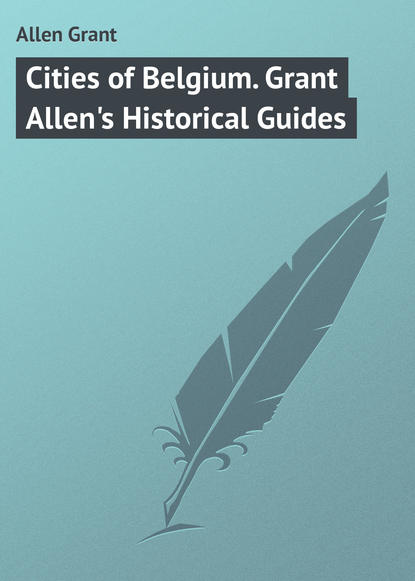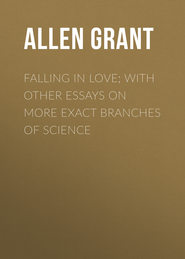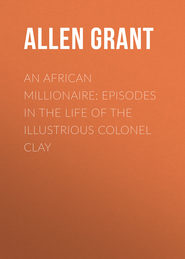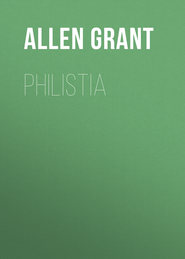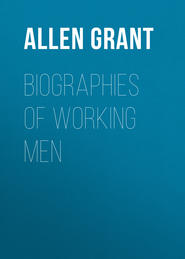По всем вопросам обращайтесь на: info@litportal.ru
(©) 2003-2024.
✖
Cities of Belgium. Grant Allen's Historical Guides
Настройки чтения
Размер шрифта
Высота строк
Поля
Most visitors to Ghent go to see the Grand Béguinage. This was originally situated in a little district by itself, close to the gate of the Rabot, where its church, uninteresting, (dedicated, like that of Bruges, to St. Elizabeth of Hungary), still stands; but the site has been occupied by the town for new streets. The present Grand Béguinage lies on the road to Antwerp. It is a little town in miniature, enclosed by wall and moat, with streets and houses all very neat and clean, but of no archæological interest. Yet it forms a pleasant enough end for a short drive. And you can buy lace there. The description in Baedeker is amply sufficient.
Bruges is full of memories of the Burgundian Princes. At Ghent it is the personality of Charles V., the great emperor who cumulated in his own person the sovereignties of Germany, the Low Countries, Spain and Burgundy, that meets us afresh at every turn. He was born here in 1500, and baptized in a font (otherwise uninteresting) which still stands in the N. Transept of the Cathedral. Ghent was really, for the greater part of his life, his practical capital, and he never ceased to be at heart a Ghenter. That did not prevent the citizens from justly rebelling against him in 1540, after the suppression of which revolt Charles is said to have ascended the Cathedral tower, while the executioner was putting to death the ringleaders in the rebellion, in order to choose with his brother Ferdinand the site for the citadel he intended to erect, to overawe the freedom-loving city. He chose the Monastery of St. Bavon as its site, and, as we have seen, built there his colossal fortress, now wholly demolished. The Palace in which he was born and which he inhabited frequently during life, was known as the Cour du Prince. It stood near the Ancien Grand Béguinage, but only its name now survives in that of a street.
The Spaniard’s Castle was long the standing menace to freedom in the Low Countries. Within its precincts Egmont and Hoorn were imprisoned in 1568 for several months before their execution.
During the early Middle Ages, the Oudeburg was the residence of the Counts of Flanders in Ghent. Later on, that castellated building grew out of keeping with the splendour of the Burgundian Princes, and its place as a royal residence was taken by the Cour du Prince, already mentioned, which was inhabited by Maximilian and his wife, Mary of Burgundy, as well as by Philippe le Beau and Johanna of Spain, the parents of Charles V. No direct memorials of the great Emperor now exist in Ghent, his statue in the Marché du Vendredi having been destroyed; but a modern street commemorates his name, and mementoes of him crop up at every point in the city.
Though the Ghenters were rebellious subjects, Charles V. was proud of his capital, and several of his very bad bon mots, punning on the words Gand and gant, have been preserved for us. As Baedeker repeats these imperial jests, however, I need not detail them.
III
BRUSSELS
A. ORIGINS OF BRUSSELS
BRUSSELS was in a certain sense the ancient capital of Brabant, as Bruges and Ghent were the ancient capitals of West and East Flanders. It grew up (as early as the 8th century) on the banks of the little river Senne, whose course through its midst is now masked by the modern Inner Boulevards, built on arches above the unseen stream. The Senne is one of the numerous rivers which flow into the Schelde, and the original town clustered close round its banks, its centre being marked by the Grand’ Place and the church of St. Nicolas. Unlike Bruges and Ghent, however, Brussels has always been rather an administrative than a commercial centre. It is true, it had considerable trade in the Middle Ages, as its fine Hôtel-de-Ville and Guild Houses still attest; but it seems to have sprung up round a villa of the Frankish kings, and it owed at least as much to its later feudal lords, the Counts of Louvain, afterwards Dukes of Brabant, and to their Burgundian successors, as to its mercantile position.
The Senne was never a very important river for navigation, though, like most of the Belgian waterways, it was ascended by light craft, while a canal connected the town with the Schelde and Antwerp: but the situation of Brussels on the great inland trade route between Bruges or Ghent and Cologne gave it a certain mercantile value. Bruges, Ghent, Brussels, Louvain, Maastricht, and Aix-la-Chapelle all formed stations on this important route, and all owed to it a portion of their commercial prestige.
The burgher town which was thus engaged in trade and manufactures was Flemish in speech and feeling, and lay in the hollow by the river and the Grand’ Place. But a lordly suburb began to arise at an early date on the hill to eastward, where the Counts of Louvain built themselves a mansion, surrounded by those of the lesser nobility. After 1380, the Counts migrated here from too democratic Louvain. Later on, in the fifteenth century, the Dukes of Burgundy (who united the sovereignty of Brabant with that of Flanders) often held their court here, as the population was less turbulent and less set upon freedom than that of purely commercial and industrial Bruges and Ghent. Thus the distinctive position of Brussels as the aristocratic centre and the seat of the court grew fixed. Again, the Dukes of Burgundy were French in speech, and surrounded themselves with French knights and courtiers; to suit the sovereigns, the local nobility also acquired the habit of speaking French, which has gradually become the language of one-half of Belgium. But the people of the Old Town in the valley were, and are still, largely Flemish in tongue, in customs, in sympathies, and in aspect; while the inhabitants of the Montagne de la Cour and the court quarter generally are French in speech, in taste, and in manners. We will trace in the sequel the gradual growth of Brussels from its nucleus by the river (the Lower Town), up the side of the eastern hill to the Palace district (the Upper Town), and thence through the new Quartier Léopold and the surrounding region to its modern extension far beyond the limits of the mediæval ramparts.
Choose an hotel in the airy and wholesome Upper Town, as near as possible to the Park or the Place Royale.
St. Michael the Archangel is the patron saint of Brussels: he will meet you everywhere, even on the lampposts. For the patroness, St. Gudula, see under the Cathedral.
B. THE HEART OF BRUSSELS
[The nucleus of Brussels, as of Paris, was formed by an island, now no longer existing. Round this islet ran two branches of the little river Senne, at present obliterated by the Inner Boulevards. Brussels, in short, has denied its parentage; the Senne, which is visible N. and S. of the Outer Boulevards, being covered over by arches within the whole of the Inner City.
The centre of the island is marked by the little Place St. Géry, which the reader need not trouble to visit. Here, at the end of the 6th century, St. Géry, Bishop of Cambrai and apostle of Brabant, built a small chapel, succeeded by a church, now demolished. The true centre of Brussels, however, may be conveniently taken as the existing Bourse. Close by, as the town grew, the Grand’ Place or market-place was surrounded by noble mediæval and Renaissance buildings. To this centre then, the real heart of Brussels in the Middle Ages, we first direct ourselves.]
Go from your hotel to the Grand’ Place. It may be reached by either of two convenient roads; from the Place Royale by the Montagne de la Cour and the Rue de la Madeleine, or from the Park by the Montagne du Parc (which takes various names as it descends), and the Galérie St. Hubert. Either route brings you out at the end of the Galérie, whence a short street to the L. will land you at once in the Grand’ Place, undoubtedly the finest square in Europe, and the only one which now enables us to reconstruct in imagination the other Grand’s Places of Belgium and the Rhine country.
The most conspicuous building in the Place, with the tall tower and open spire, is the Hôtel-de-Ville, with one possible exception (Louvain) the handsomest in Belgium. It consists of a tapering central tower, flanked by two wings, their high-pitched roof covered with projecting windows. The ground floor is arcaded. The first and second floors have Gothic windows, altered into square frames in a portion of the building. The edifice is of different dates. The original Hôtel-de-Ville consisted only of the wing to your L., as you face it, erected in 1402. The R. wing, shorter in façade, and architecturally somewhat different, was added in 1443. The style of the whole, save where altered, is Middle Gothic “Decorated”). The beautiful open spire should be specially noticed. On its summit stands a colossal gilt metal figure (1454) of the Archangel Michael, patron of the city. The statues in the niches are modern, and not quite in keeping with the character of the building. Observe, over the main portal, St. Michael, patron saint of the town, with St. Sebastian, St. Christopher, St. George, and St. Géry. Below are the Cardinal Virtues. The figures above are Dukes of Brabant. Inspect the whole façade carefully. You will hardly find a nobler piece of civic architecture in Europe. The carved wooden door has also a figure of St. Michael. The gargoyles and the bosses near the staircase entrance to the L. are likewise interesting.
Now, go round the corners to the L. and R., to inspect the equally fine façades, facing the Rues de l’Hôtel-de-Ville and de la Tête-d’Or. The back of the building is 18th century and uninteresting. You may also pass rapidly through the courtyard, which however has very little character. But you need not trouble to inspect the interior, unless you are an abandoned sight-seer.
The other important and beautiful building which faces the Hôtel-de-Ville is the Maison du Roi, formerly used as the Halle au Pain or Broodhuis. It is of late florid Gothic, verging towards Renaissance (1514, restored:) and is in three storeys, two of them arcaded. The first floor has an open gallery, like the loggia of a Venetian palace, whence ladies could view processions and ceremonies in the square below. The building terminates in a high roof, with projecting windows, and a handsome open tower and lantern. The whole has been recently rebuilt and profusely gilded. Within, is a small Communal Museum (open free daily, 10 to 4). Come again often to view these two noble halls.
The third principal building (on the E. side of the Square) known as the Maison des Ducs was the Public Weighing House, constructed in a debased Renaissance style, and also profusely gilded. It bears the date 1698, but is now unworthily occupied by sale rooms and shops.
The whole of the remaining space in this glorious square is surrounded by magnificent Guild Halls of the various corporations.
Beginning on the S. side (that occupied by the Hôtel-de-Ville), we have, first, L., two high-gabled houses of good 17th century domestic architecture. Next to them, R., comes the Hôtel des Brasseurs, dated 1752, and lately surmounted by a bronze equestrian statue of Charles of Lorraine. This was originally the Guild Hall of the Brewers. After that, again, rises the house known as “The Swan,” belonging to the Corporation of Butchers. The small building at the corner, next the Hôtel-de-Ville, with an open loggia, now in course of restoration, is known as the Maison de l’Étoile: a gilt star surmounts its gable.
The finest group of houses, however, is that to the W. side of the Square (R. of the Hôtel-de-Ville), unoccupied by any one prominent building. Beginning on the L., we have, first, the house known as “The Fox” (Le Renard), dated 1699: it is surmounted by a figure of St. Nicholas resuscitating the three boys, and is adorned with statues of Justice and the Four Continents on its first floor. Then comes the Guild Hall of the Skippers, or Maison des Bateliers, its gable constructed somewhat like the poop of a ship. The symbolism here is all marine – sailors above; then Neptune and his horses, etc. R. of this, we see the house known as “La Louve,” bearing as a sign Romulus and Remus with the wolf. This was originally the Guild Hall of the Archers. It shows an inscription stating that it was restored, after being burnt down, by the Confraternity of St. Sebastian (patron of archers). Its relief of the Saint with a bow is appropriate. The two remaining houses are “La Brouette,” dated 1697, and “Le Sac,” bearing on its gable a medallion with three faces.
The houses on the N. side, (that occupied by the Maison du Roi,) are less interesting, except those on the extreme R. Next to the Maison du Roi itself come two pretty little decorated houses, beyond which is the Guild Hall of the Painters, known as “The Pigeon,” and that called “La Taupe,” the Hall of the Tailors. The two last at the corner of the street have been recently restored. Several other fine houses of the same period close the vista of the streets round the corner.
This imposing group of Guild Halls dates, however, only from the end of the 17th century, mostly about 1697. The reason is that in 1695 the greater part of the Grand’ Place was destroyed by Marshal de Villeroi during the siege. Two years later, the Guild Houses were rebuilt in the ornate and somewhat debased style of the Louis XIV. period. Fortunately, the two great mediæval buildings, which stood almost isolated, did not share the general destruction.
Continue your stroll through the Lower Town.
From the Grand’ Place, take the Rue au Beurre, which leads W. towards the Bourse. On your R. you will pass the now uninteresting and entirely modernized Church of St. Nicolas. In its origin, however, this is one of the oldest churches in Brussels, and though it has long lost almost every mark of antiquity, it is instructive to recognise here again (as at Ghent) the democratic patron saint of the merchants and burgesses in close proximity to their Town Hall and their Guild Houses. The Bourse itself, which faces you, is a handsome and imposing modern building. Go past its side till you reach the line of the Inner Boulevards, which lead N. and S. between the Gare du Nord and the Gare du Midi.
This superb line of streets, one of the finest set of modern boulevards in Europe, has been driven straight through the heart of the Old Town, and the authorities offered large money prizes for the best façades erected along the route. Content yourself for the moment with a glance up and down, to observe the general effect, and then continue on to your L. along the Boulevard, where the first street on the R. will lead you to the little Place St. Géry, now occupied by a market, but originally the centre of Old Brussels. A stroll through the neighbouring streets is interesting, past the Halles Centrales, and the modern Church of St. Catherine, close by which stands the old Tower of St. Catherine, built into a modern block of houses. A little further on is the picturesque Tour Noire, the only remaining relic of the first fortifications of the city. You may prolong this walk to the Place du Béguinage, with a tolerable church. The quarter has no special interest, but it will serve to give you a passing idea of the primitive nucleus of mediæval Brussels.
I will interpolate here a few remarks about the more modern portion of the Old Town. The best way to see it is to take the tram along the Inner Boulevards from the Gare du Midi to the Gare du Nord. You will then pass, first, the Outer Boulevards (see later): next, R., the Palais du Midi; L., the Place d’Anneessens, with a statue of Anneessens, the intrepid and public-spirited magistrate of Brussels who was put to death in 1719 for venturing to defend the privileges of the city against the Austrian authorities. Just opposite this, you get a glimpse, R., of the Place Rouppe, to be noticed later. Passing the Place Fontainas, where many streets radiate, you arrive at the Bourse, already noticed. The handsome corner building (with dome) in front of you, which forms so conspicuous an element in the prospect as you approach, is the Hôtel Continental. Just in front of it expands a small new square (Place de Brouckere) still unfinished, on which a monument is now being erected to a late burgomaster (De Brouckere.) At this point, the Boulevard divides, the western branch following the course of the Senne (which emerges to light just beyond the Outer Boulevards,) while the eastern branch goes straight on to the Gare du Nord, passing at the first corner a handsome narrow house with gilt summit, which won the first prize in the competition instituted by the Municipality for the best façades on the new line of streets.
After reaching the Gare du Nord, you can return to the Gare du Midi by an alternative line of main streets, which also cuts through the heart of the Old Town, a little to the E. of the Inner Boulevards. It begins with the Rue Neuve, where a short street to the L. conducts you straight to the Place des Martyrs, a white and somewhat desolate square of the 18th century, (1775) adorned later with a Monument to the Belgians who were killed during the War of Independence in 1830. Shortly after this (continuing the main line) you pass two covered galleries, R. and L., and then arrive at the Place de la Monnaie. On your R. is the handsome building of the new Post Office; on your L., the white Ionic-pillared Grand Théâtre or Théâtre de la Monnaie, (opera, etc.). You then pass between St. Nicolas on the L., and the Bourse on the R., and continue on to the Place Rouppe, (ornamented with a fountain and a statue of Brussels personified): whence the Avenue du Midi leads you straight to the Place de la Constitution, in front of the South Station.
The remainder of the Western Half of the town is, for the most part, poor and devoid of interest, though it contains the principal markets, hospitals, and barracks, as well as the basins for the canals which have superseded the Senne.
C. THE PICTURE GALLERY
[I interpolate here the account of the Brussels Picture Gallery, because it is the most important object to be seen in the town, after the Grand’ Place and its neighbourhood. You must pay it several visits – three at the very least – and you may as well begin early. Follow the roughly chronological order here indicated, and you will understand it very much better. Begin again next time where you left off last: but also, revisit the rooms you have already seen, to let the pictures sink into your memory. Intersperse these visits with general sight-seeing in the town and neighbourhood.
The Brussels Gallery forms an excellent continuation to the works of art we have already studied at Bruges and Ghent. In the first place, it gives us some further examples of the Old Flemish masters, of the Van Eycks and of Memling, as well as several altar-pieces belonging to the mystical religious School of the Brussels town-painter, Roger Van der Weyden, who was Memling’s master. These have been removed from churches at various times, and gradually collected by the present Government. It also affords us an admirable opportunity of becoming well acquainted with the masterpieces of Dierick Bouts, or Dierick of Haarlem, an early painter, Dutch by birth but Flemish by training, who was town painter in democratic Louvain, (which town may afterwards be made the object of an excursion from Brussels).
But, in the second place, besides these painters of the early school, the Brussels Gallery is rich in works of the transitional period, and possesses in particular a magnificent altar-piece by Quentin Matsys, the last of the old Flemish School, and the first great precursor of the Renaissance in the Low Countries. He was practically an Antwerp man (though born at Louvain), and his place in art may more fitly be considered in the Antwerp Museum.
From his time on we are enabled to trace, in this Gallery, the evolution of Flemish art to its third period, the time of Rubens (also better seen at Antwerp) and his successors, the great Dutch painters, here fairly represented by Rembrandt, Frans Hals, Van der Helst, Gerard Dou, and Teniers.
In the following list of the most noteworthy works of each School, I have adhered, roughly speaking, to a chronological order, but without compelling the reader unnecessarily to dance up and down the various rooms of the collection from one work to another. The Gallery itself is one of the most splendid in Europe, and it has been recently re-arranged in a most satisfactory manner.]
The national collection of pictures by Old Masters occupies the very handsome modern building known as the Palais des Beaux-Arts in the Rue de la Régence, immediately after passing through the Place Royale. (Four large granite columns in front: bronze sculpture groups to R. and L.) See plan on p. 108 (#illo_108).
Enter by the big door with the four large granite columns. In the vestibule, turn to the R., and mount the staircase. Then pass through Room III. and Corridor A, to Room V. on the right, and on into
Room I
Hall of the Old Flemish Masters
This contains the most interesting works in the Gallery.
(You may also, if you like, pass through the collection of Sculpture in the Hall below, entering by Corridor D; in which case, turn to the L. into Rooms VIII. and II., and then to the R. into Room I., as above. This is the handsomer entrance. Much of the sculpture has great merit: but being purely modern, it does not fall within the scope of these Historical Guides.)
Begin in the middle of the wall, with No. 170, **Hubert van Eyck: the two outer upper shutters from the Adoration of the Lamb at Ghent, representing Adam and Eve, whose nudity so shocked Joseph II. that he objected to their presence in a church. These fine examples of the unidealized northern nude are highly characteristic of the Van Eycks’ craftsmanship. The Adam is an extremely conscientious and able rendering of an ordinary and ill-chosen model, surprisingly and almost painfully true in its fidelity to nature. The foreshortening of the foot, the minute rendering of the separate small hairs on the legs, the large-veined, every-day hands, the frank exhibition of the bones and sinews of the neck, all show the extreme northern love of realism, and the singular northern inattention to beauty. Compare this figure with the large German panels on a gold ground in the corners diagonally opposite (No. 624), if you wish to see how great an advance in truth of portraiture was made by the Van Eycks. The Eve is an equally faithful rendering of an uninteresting model, with protruding body and spindle legs. Above, in the lunettes, are the Offerings of Cain and Abel, and the Death of Abel, in grisaille. The backs of the shutters will be opened for you by the attendant. They exhibit, above, two Sibyls, with scrolls from their prophecies; below, the central portion of the Annunciation in the total picture, with a view through the window over the town of Ghent, and the last words of the angelic message, truncated from their context. This portion of the picture is, of course, only comprehensible by a study of the original altar-piece at Ghent.
THE PICTURE GALLERY AT BRUSSELS.
Continue now along this wall to the R. of the Adam and Eve.
24. J. Gossart, called Mabuse (1470-1541), triptych with a Glorification of the Magdalen, given by a special votary. The central panel contains the chief event in her history – the Supper at the House of Simon the Pharisee. The host and one guest are admirably represented by Flemish portraits, exquisitely robed, and reproduced in marvellous detail. The figure of the Christ is, as usual, insipid. Beneath the table, the Magdalen, as central figure, with her alabaster box of ointment, kisses the feet of Christ. To the right, Judas, with his traditional red hair, and bearing the purse, asks, with a contemptuous gesture, Why this was not sold and given to the poor? In the background are the Apostles. Conspicuous amongst them is the conventional round face of St. Peter. The whole scene takes place in a richly decorated interior, with charming colouring and a finely rendered clock, curtain, and other accessories. Gossart visited Italy, and was one of the earliest Flemings to be influenced by the Italian Renaissance. You will not overlook the half-Gothic, half-Renaissance architecture, nor the chained squirrel, nor the semi-grotesque episodes in the background, very domestic and Flemish. (Moses above the Pharisee’s head marks his devotion.)
The left panel has another principal event in the Magdalen’s life, the Resurrection of Lazarus. Here also the Christ is insipid, but the Peter behind him, in a green robe, is finely characterized; and the John, affected. Beside are the Magdalen (same dress as before) and Martha, with a group of women and bystanders in singular head-dresses. In the background rises a very ideal Bethany. The right panel represents the kneeling donor (an unknown Premonstratensian abbot); on his book is written, “Mary Magdalen, pray for us.” Above him is seen the floating figure of the Magdalen, clad only in her own luxuriant hair, and raised aloft by angels from her cave, the Sainte Baume, in Provence, to behold the Beatific Vision. The background has Stations of the Cross, actually copied (with the rest of the landscape) from those at the Sainte Baume, which Gossart must have visited at his patron’s instance. On the backs of the wings, yet another scene in the life of the Saint, Christ and the Magdalen in the Garden. All this triptych is finely modelled and well-coloured.
552. Three panels attributed to Roger van der Weyden, of Tournai, town painter of Brussels, and teacher of Memling – a highly symbolical and religious master. Scenes from the Life of the Virgin. In the centre, the Presentation of the Virgin in the Temple. The foreground is occupied by St. Joachim and St. Anna, parents of the little Virgin, who is seen mounting the regulation fifteen steps of the Temple, assisted by a somewhat unusual angel. At the head of the steps stands the High Priest. Within, the Virgins of the Lord are seen reading. To the right, still in the same panel, is the Annunciation, with the usual features, angel L., Madonna R., prie-dieu, bed, Annunciation lily, and arcade in the foreground. The left panel has the Circumcision; and the right, Christ among the Doctors in the Temple, with some excellent portraits in the background. (For Van der Weyden’s place in art, see Conway; for the Madonna ascending the steps, Legends of the Madonna.)





